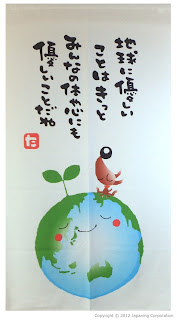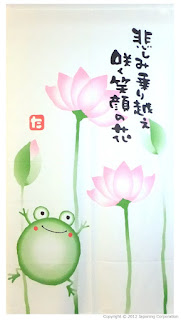Hello and Welcome to
www.nipponcraft.com,
If you are interested in printing your own design on
furoshiki, I hope this article will help you understand the characteristics of hand-printing and also its limitation.
Most of furoshiki in Japan are produced in Kyoto. This is because many factories necessary for furoshiki production are concentrated in Kyoto. Furoshiki are produced through several processes such as cutting stencils, printing design, steaming and washing furoshiki, and each factory organizes the supply chain of furoshiki production.
We, nipponcraft, have partner factories in Kyoto and I shot these photos and interviewed artisans there.


First of all, you may wonder about the granularity of design but we can print a pattern as complex as the one you can see in the left photos. We can print many elaborate designs and patterns on furoshiki. But the thickness of lines and the circle diameter need to be more than 2mm.
This printed paper arrived from a customer for printing on furoshiki. I hope you can get an idea of the level of complexity we can manage to print.
This furoshiki is designed by a Finland designer and the furoshiki are sold at Japanese department stores. In these days, many furoshiki are designed by European designers, and many Japanese customers are accepting this movement.
To print your design on furoshiki, we prepare stencils at first. We prepare stencils of number of colors you want to print on furoshiki.
These days, many customers make their own designs on PCs, and the stencils are cut with the help of computers. So, your design can be exactly copied to furoshiki stencils.
These stencils can be kept in good condition for four to five years, and can be used for additional orders.
You can send your desired colors by either of Adobe, GIF or even printed papers with color swatches. In Japan, DIC color swatch is common but we can accept Pantone color swatch from international customers.
Then, an artisan will translate your desired color to a dyeing material mix. He has notebooks that keep huge number of mixes to make various colors. If he doesn't find the customer's color within his knowledge, he will create it. Many artisans say (boast?) that they can create infinit number of colors to reach customer's desire.
Next, an artisan starts to mix base color materials. He is a professional of color mixer and he knows the right mix to reproduce your desired color. He makes colors though his eyes and experiences. Moreover, the mix needs to be changed slightly according to the weather, humidity and also the materials for printing such as cotton or rayon. The artisan makes every effort to produce the best color for furoshiki.
However, the artisan insists that color reproduction is human oriented work and that final color might be adjusted by him. The customer's desired color largely depends on a computer screen resolution, printer and ink type. And sometimes an artisan cannot reproduce the exact computer colors on cotton or rayon. So, an artisan always provides a
test print to customers to avoid misunderstanding before producing furoshiki. He always makes sure if you are satisfied with the color that the artisan created. This is the best way to prevent miscommunication between customers and artisans. An artisan will update the color mix by your feedback. This process may be done two or three times. But an artisan says that he might never print exact the same color printed on papers on furoshiki cloth.
Print materials are now ready.
The white furoshiki cloth are laid for printing. The cloth is so long that it will be cut into furoshiki size in an afterward process.
An artisan hand-prints a pattern by overlaying a stencil on furoshiki cloth and pasting color material from top to bottom. He does this work continuously by moving a stencil from a section to a section. It looks easy but actually it needs lots of experience to print furoshiki of a commercial values. What is surprising is that the pattern are printed seamlessly as if there are no joint parts.
Finally, beautiful furoshiki cloth are printed.
This is a small notification. Unlike "Chu-sen" tenugui, furoshiki backside is not dyed. (Both sides of "Chu-sen" tenugui are dyed.)
The printing factory does not look fancy but many experienced artisans are working and some young people are learning skills to be a good artisan in the future.
It is true that inkjet prints are becoming prevalent even in Kyoto for seeking low cost. But hand-printed furoshiki will give you a human toutch. Hand-print might not be as perfect as inkjet printers, but there is nothing so perfect in nature and this lack of perfectness will give you a relief and comfort.
We hope that not only Japanese customers but also you will utilize these Japanese internal skills to add your life natural tastes!
Thank you for visiting our blog!






















